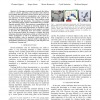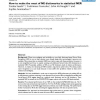16160 search results - page 123 / 3232 » How to approach humans |
HRI
2006
ACM
14 years 2 months ago
2006
ACM
Autonomous robots use sensors to perceive and track objects in the world. Tracking algorithms use object motion models to estimate the position of a moving object. Tracking effic...
ABIALS
2008
Springer
13 years 10 months ago
2008
Springer
Abstract. Prediction and Planning are essential elements of successful human driving, making them equally important for autonomously driving systems. Many approaches achieve planni...
ICRA
2009
IEEE
14 years 2 months ago
2009
IEEE
— In this paper, we present an approach that allows a robot to observe, generalize, and reproduce tasks observed from multiple demonstrations. Motion capture data is recorded in ...
AGP
2010
IEEE
13 years 11 months ago
2010
IEEE
This chapter tackles the relation between declarative languages and multi-agent systems by following the dictates of the five Ws (and one H) that characterize investigations. The ...
BMCBI
2008
13 years 8 months ago
2008
Background: When term ambiguity and variability are very high, dictionary-based Named Entity Recognition (NER) is not an ideal solution even though large-scale terminological reso...


